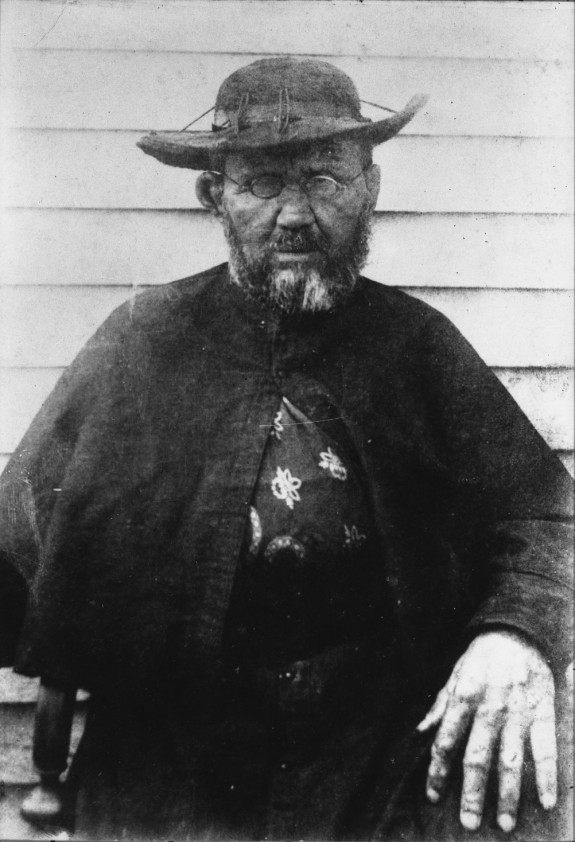Today we continue our regular series called “Learning from the Saints.” Our guide is expert Bert Ghezzi, a dear friend of mine and the author of numerous books including Voices of the Saints, Saints at Heart, and Discover Christ: Developing a Personal Relationship with Jesus.
His more recent books are The Power of Daily Mass and The Heart of Catholicism. You can learn more about Bert and his work at BertGhezzi.com.
Today, Bert profiles St. Damien of Molokai, the patron of people with Hansen’s Disease (commonly known as leprosy.)
“I make myself a leper with the lepers to gain all for Christ.”
— St. Damien de Veuster
In 1873, Belgian Father Damien de Veuster volunteered to serve the lepers at Molokai. Shortly after the young missionary arrived in Hawaii eight years before, a leprosy epidemic struck the islands, and victims were herded into isolation. Even though he had a premonition that he would die a leper, he under took his assignment with excitement. “I—I want to go there!” he had told his bishop. “I know many of these unfortunate souls and I ask only to share their lot and their prison.”
 And Damien found that Molokai was indeed a prison—of degradation, suffering and death. Although engulfed by hopelessness, he refused to submit to it. Immediately, Damien set out to restore the dignity of the lepers. He treated them not as victims, but as ordinary human beings. He organized them into work groups that constructed roads, cottages and clinics. He established a cemetery and built coffins for them, improving their lives by making their deaths respectable. For the sports-loving Hawaiians he organized foot races, even though some competitors had lost their feet. He cheered the island by forming a choir and a band. Two organists who had ten fingers between them played at funeral masses.
And Damien found that Molokai was indeed a prison—of degradation, suffering and death. Although engulfed by hopelessness, he refused to submit to it. Immediately, Damien set out to restore the dignity of the lepers. He treated them not as victims, but as ordinary human beings. He organized them into work groups that constructed roads, cottages and clinics. He established a cemetery and built coffins for them, improving their lives by making their deaths respectable. For the sports-loving Hawaiians he organized foot races, even though some competitors had lost their feet. He cheered the island by forming a choir and a band. Two organists who had ten fingers between them played at funeral masses.
Damien took no precautions in personally caring for his people. Though often sickened by the overwhelming stench of their rotting flesh, daily he touched, hugged and bathed them. “I have seen him,” said a visitor, “dress the most loathsome sores as if he were arranging flowers.”
Father Damien never rested. When he was not tending to the needs of his beloved lepers, he was pressuring the government for more money and medical resources for the colony. He finally contracted the dread disease and died at Molokai on April 15, 1889.
The saint was always gentle with others, but like *St. Peter Claver, hard on himself. We admire his self-abnegation, but recoil from the thought of doing what he did. We don’t easily understand such selflessness, but perhaps Damien’s “personal rule,” quoted below, explains something of the force that drove him:
“The memory of your past infidelities must move you at each present moment to acts of humility and contrition, with the renewing of firm vows for the future. Be severe toward yourself, indulgent toward others. Have a scrupulous exactitude for everything regarding God, that is, in prayer, meditation, celebration of mass and the sacraments.
“Unite you heart with God. And especially, in the midst of temptation, protest ceaselessly that you die instantly rather than consent to the least venial sin. May passion lead you continually to whisper these words: ‘I wish to be dissolved and to be with Christ.’ To stave off consent to sin, remember the invisible judgment of God, who watches and knows all the actions of your free will.
“Be good. Be vigilant. Remember always your three vows by which you are dead to the things of the world. All that you have is only for you to use, not your personal property. Death to the pleasures of the flesh: purity makes you like an angel. Impurity makes a devil out of a priest. No sensuality, no looking for ease. Death to all the caprices of your own will. As with the corpse, let your superiors do what they think best with you.
“Remember always the immutability of God, and imitate it by a patience in the face of all tests. Remember always that God is eternal. Work courageously in order one day to be united with him forever.”
(Image Credit: Wikipedia)
Read more from Bert at his website www.BertGhezzi.com, or check out his many books on Amazon.

